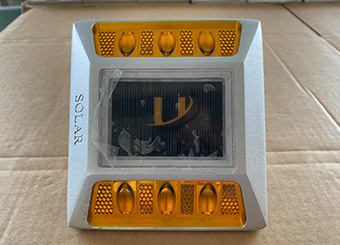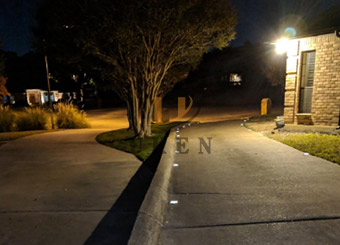In the global road system, road studs can be described as ubiquitous. From stretching thousands of miles of motorway, to the bustling city streets, and then to the quiet remote country lanes, it is firmly ‘rooted’. Road studs in guiding traffic, security, play an irreplaceable role, like a tiny lighthouse in the dark night, for drivers to guide the road. However, behind its wide application, but hides some easy to be ignored, but really affect the road experience and safety and security disadvantages.
Dependence on external light sources
Traditional reflective road studs, themselves do not have the ability to light up, its reflective effect is completely dependent on external light sources such as vehicle headlights. In the road at night with low traffic flow, there is no continuous vehicle light irradiation, road studs will fall into the ‘darkness’, and can not take the initiative to outline a clear outline for the road. There are also those remote areas, the light conditions themselves are poor, once the lack of vehicle passing light, the road instantly becomes blurred, the driver is difficult to accurately judge the road boundary and direction, greatly increasing the risk of driving.
Reflective distance and angle limitations
The reflective distance of the traditional road spike is quite limited, generally speaking, its effective visual distance is only about 50 metres. For high-speed vehicles, this distance is far from enough to allow drivers to do a good job in advance of road conditions and response to prepare. Moreover, its reflective angle also has obvious limitations. When the vehicle driving angle deviates from the best reflective direction of the road spike, the reflected light will be greatly reduced, and even almost no reflection. In some curved roads, this situation is particularly obvious, the driver is likely because of the poor reflective effect of the road spike, and misjudge the direction of the road, resulting in vehicle deviation from the lane, triggering traffic accidents.
Limited light intensity
Although the solar studs can actively light, seemingly solving part of the problem of the traditional studs, but it also exists in its own light intensity is not enough defects. In the rainstorm pouring down, the rain continues to wash the surface of the road spike, will interfere with its light propagation, the light is easily covered by the rain curtain. In foggy weather, light scattering is serious, and the light of the solar road studs appears particularly weak in the fog, making it difficult to penetrate the fog and clearly guide the road for drivers. What’s worse, under the interference of the glare from the high beams of oncoming vehicles, the lights of the solar road studs will be instantly ‘drowned out’, the warning effect is greatly reduced, seriously affecting the driver’s judgement of the road conditions.
Unstable range
Solar road studs rely on solar charging to maintain night work. However, once encountered continuous cloudy days, rainy days, insufficient light, solar panels can not fully absorb solar energy for charging, its battery life will be greatly affected. With the gradual decrease of battery power, the brightness of the light of the road studs will continue to diminish, until finally completely extinguished. In some mountainous areas, the weather is changeable, continuous rainy weather is not uncommon, which makes the solar road spike can not continue to provide stable road lighting and warning, to the night driving safety brings great danger.
Vehicle crushing damage
Road studs every day to withstand a large number of vehicles frequently crushed, especially in the traffic flow of the main road, as well as heavy vehicles to and from frequent road sections, the destructive power of this crushing is more significant. Under prolonged pressure, the shell of the spike is very easy to crack, the internal electronic components, reflective materials and other components are also prone to damage. For example, in some freight hubs near the road, due to the heavy truck traffic, road spike every 2 – 3 months on average need to be replaced, the service life is very short.
Natural erosion
Road spike long-term exposure to the natural environment, subject to wind, sun, rain, ice and other natural factors of erosion. Spike made of metal, in the rain and oxygen in the air under the joint action, very easy to rust and corrosion, resulting in a decline in structural strength. Road spike made of plastic, after a long time of ultraviolet radiation, will gradually aging brittle, lose the original toughness and durability. In the northern cold regions, winter freezing weather will make the road studs internal water ice expansion, further damage to the structure of the spike, greatly shortening the normal service life of the spike.
Frequent Replacement Costs
Due to the poor durability of road spikes, frequent replacements are the norm, which leads to an accumulation of costs for purchasing new spikes. Take a section of 10 kilometres of highway as an example, assuming that each kilometre of the installation of 100 road nails, each road nails cost $ 10, replaced twice a year, then only the purchase of road nails material costs up to $ 20,000 per year. This cost will continue to rise as spikes are damaged more frequently and as material prices fluctuate.
Labour Maintenance Costs
Replacing spikes is not a simple task and requires lane closures and professional crews. The process is not only labour-intensive but also time-consuming. For each maintenance, the labour cost, together with the indirect cost of manpower and material resources required for traffic control, is a considerable amount of expenditure. In urban roads, due to the greater difficulty of traffic control, each spike maintenance of labour and indirect costs may be as high as thousands of dollars, so that the overall maintenance cost of the road spike for a long time remains high.
Rain and fog weather failure
In heavy rain, rain will quickly wash the surface of the spike, for reflective studs, which will wash away the surface of the reflective coating, seriously affecting the reflective effect. Solar road studs may be caused by water leading to internal circuit short circuit, directly can not work properly. Foggy weather is known as the ‘nemesis’ of the road studs, light in the fog serious scattering, whether relying on reflective traditional road studs, or active light-emitting solar studs, its lighting and warning signals are difficult to penetrate the fog, passed to the driver’s eyes, almost completely out of action, greatly increasing the risk of driving in rainy and foggy weather.
Extreme Temperature Impact
In a high temperature environment, the material properties of the spike will change significantly. The plastic casing will become soft, and the originally strong adhesive may also fail, resulting in loose or even deformed studs, which cannot maintain a normal working condition. In the low-temperature environment, for solar spikes, the battery performance will be greatly reduced, the ability to store and discharge power is weakened, the brightness of the light is not stable. Metal studs will become brittle, more easily damaged in the vehicle crush, in the northern cold areas, the damage rate of winter studs is often several times higher than other seasons.
Complex terrain problems
In mountainous, hilly and other complex terrain areas, road slopes, curves, the traditional spike installation is extremely difficult. Due to the undulation of the terrain, it is difficult to ensure the level and stability of the spike installation, which in turn affects its reflective and warning effect. Solar road studs, due to complex lighting conditions, sunlight may be blocked by mountains, trees, etc., it is difficult to achieve a stable power supply, and can not provide continuous, effective lighting warning, the application in these areas is greatly restricted.
Risk of chemical corrosion environment
In areas close to chemical plants, salt farms, etc., the air is filled with corrosive chemicals, and the ground may also have acidic or alkaline substances. Road studs are highly susceptible to corrosion damage when they are exposed to such environments for long periods of time. For example, in the salt field near the road, road nails may be corroded in just a few months to the face, the service life is significantly shortened, so that the installation of road nails in such environments become extremely uneconomical, and even can not be used normally.
Construction caused by congestion
Road spike installation or replacement construction, inevitably need to close part of the lane. In road sections with heavy traffic flow, this initiative is very likely to cause traffic congestion. For example, in the morning rush hour, once a lane is closed for stud maintenance, the length of the vehicle queue may increase by 2 – 3 kilometres in a short period of time, the speed of the vehicles will drop significantly, and the originally smooth traffic will be thrown into chaos instantly, causing great inconvenience to the public and seriously affecting the efficiency of the city’s traffic operation.
Construction Time Restriction
In order to minimise the impact on traffic, road stud construction can only be carried out at night or during low traffic hours. However, the poor light conditions of night construction, increasing the difficulty of construction, and construction personnel working at night, energy and attention will also be affected to a certain extent. At the same time, the traffic trough time is often limited, which limits the construction progress, so that the maintenance of the road spike can not be timely and efficiently completed, further affecting the normal maintenance cycle of road facilities.
Vehicle bumps risk
In order to ensure the reflective or lighting effect, some road studs will protrude from the road surface to a certain height. When the vehicle is driven over, the tyres will come into contact with the spike, resulting in an obvious bumpy feeling. When the vehicle is travelling at high speed, this bump may interfere with the driver’s control of the vehicle’s stability, especially for some special vehicles or motorbikes with high requirements for vehicle control, the bumps bring more risk, and may even lead to loss of control of the vehicle, increasing the probability of traffic accidents.
Noise pollution
Vehicle tyres rubbing against road studs will produce sharp noise. In road sections with heavy traffic flow, the noise generated by the friction between many vehicles and the road studs will be superimposed, resulting in serious noise pollution. This noise will not only interfere with the normal life of the surrounding residents, affecting their rest and physical and mental health, but also contrary to the construction concept of modern cities in pursuit of a green and quiet traffic environment, which is not conducive to the sustainable development of the city.
Road studs in the lighting warning performance, the traditional road studs rely on external light sources and reflective limited, solar stud light intensity and range is not stable; durability, subject to vehicle crushing and natural erosion, physical wear and tear is serious, resulting in high maintenance costs; environmental adaptability is poor, poor weather and special environments, studs are easy to fail or installation restrictions; on the smoothness of the traffic, the installation and maintenance of interfering with the traffic, their own design also There are vehicle bumps and noise pollution potential. I believe that with the continuous progress of science and technology, these disadvantages are expected to be gradually overcome, road studs will be able to play a better role in providing a more reliable guarantee for road traffic safety, to create a safer and more convenient environment for people’s travel.





